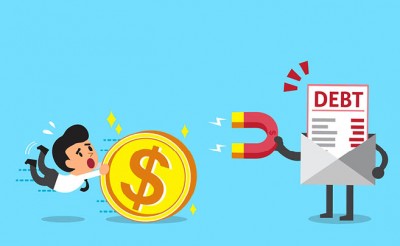The best way to tackle debt

Most of us have some form of debt; it’s a means to an end, and enables us to purchase large ticket items we can’t afford to acquire through traditional methods, such as saving or investing.
Although debt can be used as a force for good–to acquire growth and income producing assets–for many it’s used as a quick fix and can put us in a world of pain.
When debt starts getting out of hand, it can become difficult, overwhelming and frustrating, and the problem is usually the elephant in the room before we decide to do anything about it. By the time our debt is causing sleepless nights, it’s usually been sitting in our ‘too hard basket’ for quite a while.
Some argue that the best way to tackle debt is to write down all the various bills you owe, put them in order of smallest to largest, make the minimum payments on all, and start knocking off the smallest first, moving towards the largest.
The advantage of this is purely psychological, as you can see that you’re making progress by getting rid of the basic and small debt. Any progress certainly is a good thing; however, this is not necessarily the best way to tackle debt.
There are two kinds of debt; ‘good’ and ‘bad’. In order to work out what category your debt falls into, you need to ask yourself the question: "Is this debt going to be used to grow financial assets or produce an income?" If it is, it is considered ‘good debt.’ In some instances, this form of debt is also tax deductible.
Debt used to purchase items that provide no financial benefit to us–for instance, paying bills, borrowing for holidays and spending on credit for our wants–is considered ‘bad debt.’ Often, bad debt is also a money pit, with further funds required to maintain the items and cover insurance, registration and interest payments, which add up rapidly while the item depreciates in value.
In order to tackle debt, the first thing you need to do is divide it into two columns; good and bad.
Then, in each column, write the rate of interest that you pay on each of the debts. Tackling the bad debt with the highest interest rate first is actually the best way to bring down debt. Contacting the various providers, and even asking for a reduced rate of interest is also a great option, as we’re in an extremely low interest rate environment, and some providers are prepared to negotiate rather than lose the debt to another financial institution (by switching credit cards or providers). On occasion, consolidation of a few debts into one at a lower interest rate may also be an effective option, but not always! For instance, paying 9% over 5 years on a reducing sum is a lot more effective than paying 4.5% over 30 years.
If the minimum payments are being met across all debt and any extra income is able to be directed to the highest levels of bad debt, you’re going to make faster progress by reducing this first.
And every time you eliminate a debt, celebrate the win–just not with a lavish five course meal or another splurge–and then move on to the next item on the list.
Good luck!